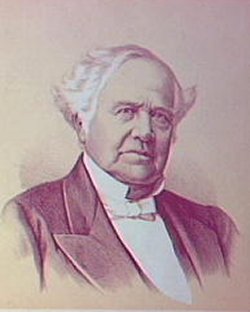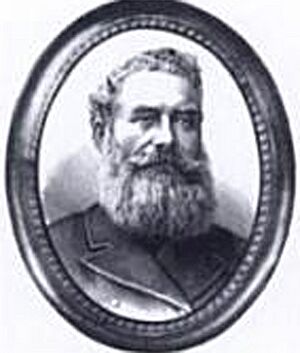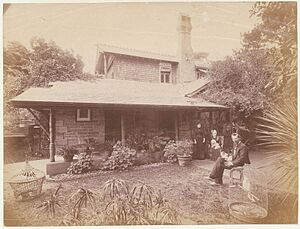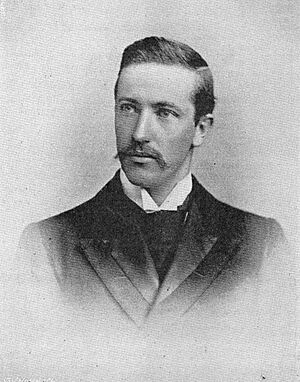Cranbrook, Bellevue Hill facts for kids
Quick facts for kids Cranbrook |
|
|---|---|
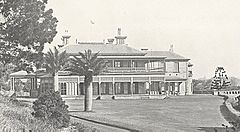
Cranbrook, Sydney, 1917
|
|
| Former names | Cranbrook Cottage |
| General information | |
| Status | Complete |
| Type | Mansion |
| Coordinates | 33°52′22″S 151°15′02″E / 33.87271°S 151.25043°E |
| Construction started | 1859 |
| Renovated | 1873-74 |
| Client | Robert Tooth |
| Owner | Cranbrook School, Sydney |
| Design and construction | |
| Architect | John Horbury Hunt (extensive renovations in 1873-4) |
| Known for | Official residence of Governor of New South Wales and Governor-General of Australia (1901-1917) |
Cranbrook is a large house built at Rose Bay in Sydney, New South Wales, Australia. Built in 1859 as a private residence, the house was used as an official residence for the Governor of New South Wales and Governor-General of Australia, it is now part of Cranbrook School.
Private residence
Robert Tooth
The Rose Bay house was built in 1859 by Robert Tooth (1821–1893), one of three brothers of the well known Sydney Tooth's Brewery family. It was named after a village in Kent, England from where the Tooth Family originated. His brother Frederick, also inherited adjoining land and on this he built his house called "Buckhurst".
Robert Towns
In 1864 Tooth sold Cranbrook to Robert Towns who was a successful Sydney merchant, shipping company owner, the founder of the city of Townsville, Queensland and a Member of the New South Wales Legislative Council. He was married to Sophia Wentworth (sister to William Wentworth) and had two sons and three daughters. When Towns died in 1873, Cranbrook was sold.
James White
James White was a pastoralist and racehorse owner. He was born in 1828 in New South Wales to relatively wealthy parents. In 1853 in partnership with his two brothers he bought Belltrees near Scone and expanded it. In about 1860 James bought Matindale near Muswellbrook where he lived with his wife Emily (née Arndell) until 1873. During this time he was a Member of the New South Wales Legislative Assembly representing the Upper Hunter. He resigned from parliament in 1868.
In 1873 he bought Cranbrook and employed John Horbury Hunt, a prominent architect, to carry out large extensions on this property. He then moved in with his wife Emily and brought into his house expensive art treasures including pictures by Italian German and English painters. In 1874 he was appointed to the New South Wales Legislative Council and over the next decade held many important posts in the Societies of that day.
White's art treasures were described in detail in a publication of that time as follows:
"The interior posses many costly art treasures - rare china of Dresden, Meissen, Sevres, and Vienna manufacture, also from Worcester and the potteries of England. In the drawing room there may be seen a magnificent specimen of ivory carving - a female figure carved from a block of ivory fully two feet long. Pictures by Italian, German and English artists decorate the walls."
These art treasures are shown below in photos of the hallway and drawing room.
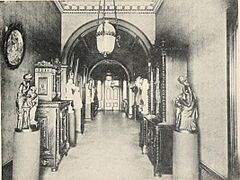 |
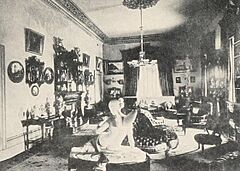 |
| The Hall in Cranbrook, 1895. | The drawing room in Cranbrook, 1895. |
One of White's main interests was horseracing and shortly after he bought Cranbrook he also purchased Kirkham near Camden where he developed his horse stud. John Horbury Hunt was commissioned to build two houses for him on this property.
One of the buildings constructed by Horbury Hunt while he was employed at Cranbrook was a stone house called Cranbrook Cottage. It appears that this was originally on White's land and was owned by him because when Cranbrook was put on the market in 1898 the advertisement stated that there were two lots to be sold. Lot 2 was described as follows:
"At the intersection of New South Head Road and Victoria Road is a stone built cottage residence at present occupied by Horbury Hunt Esq. containing hall dining and drawing rooms, 2 bedrooms, servant's room, kitchen, bathroom, boy's room and library."
Some time after this Horbury Hunt must have purchased the property as he sold it in his own name in 1902.
While James and Emily White owned Cranbrook the gardens and grounds were also developed. Horbury Hunt built a tennis pavilion (see photo below left and also below in section on garden fete) which still exists today. It is the Rotunda at Cranbrook School.
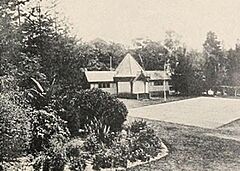 |
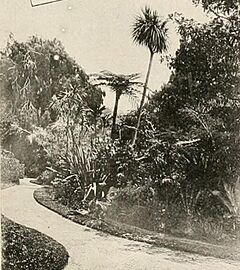 |
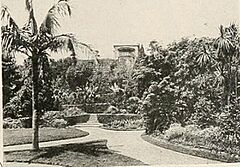 |
| The tennis pavilion at Cranbrook 1895 now the Rotunda at Cranbrook School (see also the picture below for the garden fete) |
The grounds at Cranbrook, 1895 | The garden at Cranbrook, 1895 |
A publication made the following comments about the grounds:
"The terrace in front which shuts out the high road is a very happy arrangement, and thanks to the well-stocked glass and bush houses a continuous supply of flowering plants is maintained. The Gardens and grounds are in fine order, and the view from the water side is charming."
Some of these features are shown in the photos below.
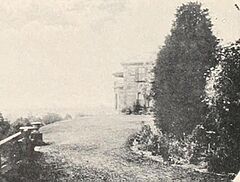 |
 |
| The terrace on the side of the house at Cranbrook, 1895. |
The pond at Cranbrook, 1895 |
White died of heart disease at Cranbrook in 1890. They had no children so Emily inherited both Cranbrook and Kirkham. Six years later in 1896 Emily, who was then 62, married Captain William Scott, aged 37. Scott was a veterinary surgeon in the NSW Defence Forces. In the following year Emily and Captain Scott sailed to Scotland but unfortunately Emily died shortly after arriving and was buried at Melrose, Roxburghshire in Scotland. Scott inherited all her property and the following year 1898 put both Cranbrook and Kirkham on the market. He sold Kirkham in the same year but did not sell Cranbrook.
The Lovely family
William Harvey Chapman Lovely, an attorney of the South Kalgurli Gold Mines Ltd and his wife Florence Emily May née Anderson (daughter of George Anderson and Emma Jane née Bell) lived in Cranbrook, Rose Bay from c. 1899 to 1900 (likely rented). It was reported in The Sydney Morning Herald that on 10 July 1899:
"Mrs Harvey Lovely gave an "at home" at her residence, Cranbrook, Rose Bay and despite the inclemency of the weather, a large number of guests were present... entertainment provided by Miss Kate Rooney, Miss Esmond (Mrs Skrine), the Misses Paterson, Miss Lilian Frost, Mr Burns Walker and Mr Grist. Those invited included Sir Matthew and Lady Harris, Miss Harris, Major-General and Mrs French, Sir William P. Manning and Lady Manning, Mr and Mrs A. Allen, Colonel and Mrs Lassetter, Mr and Mrs Teece, Dr and Mrs Newmarch, Cr and Mrs Hamilton Marshall, Mr and Mrs Macarthur, Mr and Mrs Macdonald, Mr and Mrs H. Levy, Mr and Mrs Mongomerie Servern, Mrs Acheson, Miss Plunkett, Major and Mrs Lee, Mr and Mrs J. L. Mullins, Mr and Mrs G. Cruikshank, Mr and Mrs Noyes, Mr and Mrs Walker, the captain and officers of H.M.S. Katoomba, H.M.S. Goldfinch and Pylades.."
Their stay in Cranbrook was short, as by 10 March 1900 Lovely sold up all household goods in "consequence to his departure to Europe". Whilst we find that Florence departed on 11 April 1900 for England on the H.M.S. Omrah, she returned to Australia and set up home in Randwick where their daughter, Gwendolyne Harvey Lovely, was born on 22 November 1900 and later died 5 months on 16 April 1901.
William and Florence Lovely separated and later divorced in South Africa according to the South African Divorce Archives. William married Trixie Linnelle Whiteman and raised their family in Queensland. According to newspaper reports William went out on his own rather than accept any position under a South African company deciding not to remain in South Africa and set up home in Winton.
Cranbrook School
In 1917 the NSW Government put Cranbrook up for auction. It was purchased by Samuel Hordern on behalf of a group of men from the Church of England who had decided to utilise it as a school. In July 1918 Cranbrook School was officially opened and is still operating.


